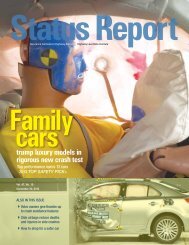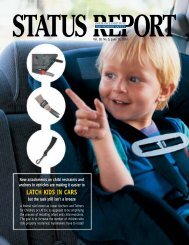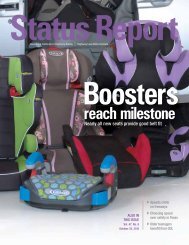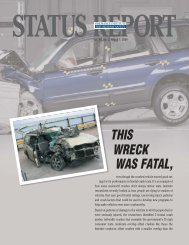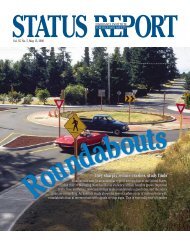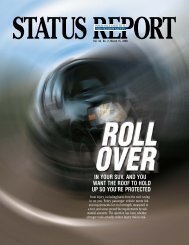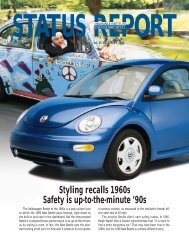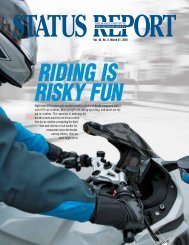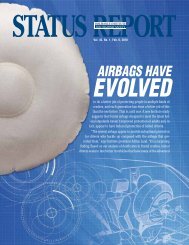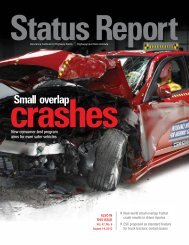Plaudits Come Easily From People Who've Been in Air Bag Crashes ...
Plaudits Come Easily From People Who've Been in Air Bag Crashes ...
Plaudits Come Easily From People Who've Been in Air Bag Crashes ...
Create successful ePaper yourself
Turn your PDF publications into a flip-book with our unique Google optimized e-Paper software.
2-11HSStatus Report, VOl. 28, No. J I, October 9, 1993Compari8oos by Impact Directlon: F6rthree years, Institute researchers havebeen evaluat<strong>in</strong>g air bag effectiveness bycompar<strong>in</strong>g driver deaths <strong>in</strong> crashes for twogroups Qf cars, these with lap/shoulderbelts plus air bags and similar cars withbelts only. Because air bags are designed towork <strong>in</strong> front and front-angJe crashes (pr<strong>in</strong>cipalpo<strong>in</strong>t of impact from 10 to 2 o'clock,given 12 o'clock as the center front of a vehicle),the proportion of driver deaths <strong>in</strong>uch crashes should be lower with air bagscompared with belts only, This would betrue if the air bags are sav<strong>in</strong>g lives.In fa,ct, the proportion of deaths is lowerwith air bags. Based on new studies ofabout 18,000 driver crash deaths dur<strong>in</strong>g1985-92, researchers f<strong>in</strong>d 24 percent fewerdeaths than expected <strong>in</strong> front and frontanglecrashes of air bag-equipped ears. Inall k<strong>in</strong>ds of crashes, the death reduction is16 percent - a sav<strong>in</strong>g that's over andabove the lives already be<strong>in</strong>g saved by thebelts used <strong>in</strong> cars with air bags.Analyz<strong>in</strong>g these results accord<strong>in</strong>g toreported belt use, researchers further estimate,21 percent air bag effectiveness <strong>in</strong>frontal crashes for people us<strong>in</strong>g belts and23 percent effectiveness without belts.But there's a caveat because the <strong>in</strong>formationon belt use <strong>in</strong> crashes, even fatalone~, isn't totally reliable. This limitationshould balloted when assess<strong>in</strong>g the 21and 23 percent effectiveness estimates.Analysis by direction of impact alsosuggests. that air bags are most effective<strong>in</strong> the largest automobiles. Tn front andfront-angle crashes, the, reduction <strong>in</strong> driverdeaths is 35 percent <strong>in</strong> large cars. It's 17percent <strong>in</strong> midsize cars and 26 percent<strong>in</strong> small cars.Comparisons by Registered Vehicle:The grow<strong>in</strong>g database on air bag crashesallows Institute researchers to beg<strong>in</strong> com·par<strong>in</strong>g driver deaths per 10,000 registeredvehicles <strong>in</strong> cars dur<strong>in</strong>g their first year withair bags and their last year with belts only.To ensure that changes <strong>in</strong> the mix of cars<strong>in</strong> these two groups don't distort comparisonsbetween the groups, the results forcars with belts only are weighted to thesame mix of cars as the air bag r.esults.What researchers f<strong>in</strong>d is a driverdeath rate of 1.15 <strong>in</strong> all k<strong>in</strong>ds of crashes ofcars with belts only compared with a rateof 0.96 <strong>in</strong> cars with bags plus belts - a 16percent reduction. The reduction is 23pement <strong>in</strong> front and front-angle crashes,and both results are very close to the effectivenessestimates derived from directionof impact analyses.Also similar are <strong>in</strong>dications of greaterair bag effectiveness <strong>in</strong> large cars comparedwith smaller ones. lIt front andfront-angle crashes, researchers estimate30 percent air bag effectiveness <strong>in</strong> largecars, 23 percent <strong>in</strong> midsize cars, and 20perCent <strong>in</strong> small cars.~Various methods of estimat<strong>in</strong>g air bageffectiveness are beg<strong>in</strong>n<strong>in</strong>g to yield consistentresults," notes Institute PresidentBrian 0' el11. But, he cautions, "eventhese new estimates can be expected tochange over time with the chang<strong>in</strong>g mix ofcars with air bags. They'll also change asbelt use cont<strong>in</strong>ues to <strong>in</strong>ch upward. Theoverwhelm<strong>in</strong>g contlusion at this time isthat air bags are sav<strong>in</strong>g many motorists."
llHS Status RefJ{)rt, VoL 28, No. I I, October 9, 1993-3<strong>Plaudits</strong> <strong>Come</strong> <strong>Easily</strong> <strong>From</strong> <strong>People</strong> <strong>Who've</strong><strong>Been</strong> <strong>in</strong> <strong>Air</strong> <strong>Bag</strong> <strong>Crashes</strong>, Survey F<strong>in</strong>dsAmong the biggest fans of air bag~ arepeople who've been <strong>in</strong> crashes <strong>in</strong> whichtheir air bags deployed. Ask if serious <strong>in</strong>jurieswere prevented, and the overwhelm<strong>in</strong>ganSwer is yes. Ask motorists Uthey'reconc~med a out <strong>in</strong>juries from air bags no. Ask If they want an air bag· <strong>in</strong> theirnext car - another resound<strong>in</strong>g yes.These are the major f<strong>in</strong>dfngs of the firstsystematic survey of motorists <strong>in</strong> air bagcrashes. Researchers surveyed 215 people,or every available driver who'd been''How well do youth<strong>in</strong>k the air bag protectedyou from InJury?"76% A lot-100/0 Somewhat70/0 None-3% A little2% Increased InjUry2% Don't know<strong>in</strong> an air bag deployment crash <strong>in</strong> NorthCarol<strong>in</strong>a dut<strong>in</strong>g January-November 1991.Eighty-n<strong>in</strong>e percent said they believethe atr lJag protected them from <strong>in</strong>jury,and 76 percent said it protected them "alot." Only {our of the 215 motorists saidthey don't want an air bag <strong>in</strong> their ne«! car.Among the four drivers who said no toair bags, none suffered serious <strong>in</strong>jury. Onewas bruised 1n thecneek area. Another wasbruised <strong>in</strong> the chest area. The third had ablister on the hand, and the fourth had anabrasion on the arm.Until the North Carol<strong>in</strong>a survey wasconducted, thera had been no systematicstudy of the reported experiences of drivers<strong>in</strong> air bag cra$hes. Driver perceptionsabout how air bags perform <strong>in</strong> crashes andabout possible <strong>in</strong>juries from the bags hadcome primarily frpm media reports andcompla<strong>in</strong>ts to the National Highway TrafficSafety Adm<strong>in</strong>istration.The survey addresses drivers' recollectionsof the crash, problems related to airbag <strong>in</strong>flation, belt use, <strong>in</strong>jury type andseverity, medical treatm~t, assessment ofair bag performance, and whether the driverwO~ld want an air bag <strong>in</strong> the next car.Forty-four percent didn't recall anyth<strong>in</strong>gparticular about the deployment. Aboutone <strong>in</strong> five remembered someth<strong>in</strong>g perceivedas a problem - dus~ odor, or noise.SAme drivers re~orted they susta<strong>in</strong>ed m<strong>in</strong>@r<strong>in</strong>juries, frequently bruises. Among''Would you wantan air bag In yournext car?"96% Yes- 2"oNo20/0 Don't knowthe specific <strong>in</strong>juries described by driverswere a "bit of abrasion plus cold feelliig,""~Ilght burn on the nose," and "sore. chestand arms. ~ Among all <strong>in</strong>juries, only 7 percentwere assessed by police as anyth<strong>in</strong>gmore than moderate."These responses put some of the recentnegative reports about air bags <strong>in</strong>toperspettive," ,gays fnstitute Senior VicePresident Allan F. Williams "M<strong>in</strong>or <strong>in</strong>juriesfrem <strong>in</strong>flat<strong>in</strong>g bags aren't uppermost <strong>in</strong> them<strong>in</strong>ds, of those who've been <strong>in</strong> crashes."The survey was designed to f<strong>in</strong>d outwhat happens <strong>in</strong> air bag crashes. "Despitem<strong>in</strong>or problems such as ~brasions, drivershave aver.y favorable view," Williams adds.For a copy pf "Survey of Attitudes ofDrivers· <strong>in</strong> <strong>Air</strong> <strong>Bag</strong> Deployment <strong>Crashes</strong>" byD.W. Re<strong>in</strong>furt, A,W Green, BJ. Campbell,and A.F. Williams, write to the Institute'sCommunicatrons Department, 1005 N.Glebe Rd., Arl<strong>in</strong>gton, VA 22201.campIThe Office ofat the NatioAdm<strong>in</strong>istrpla<strong>in</strong>ts, iThiscampbags.<strong>in</strong>volvquentlylersbag vennitrogenbags, sompeople's arevents hsitloned.and theInvestigatirelativelyabout burnMore ththe camplalcom<strong>in</strong>g <strong>in</strong> ipeople whotheir air bagshould haveplayed <strong>in</strong> a colUsion but didn't.When <strong>in</strong>vestlgators look Intcompla<strong>in</strong>ts suchthese, they aimways f<strong>in</strong>d a m!8I_.-"about the cir;which air baIn particularknow airI i't Know thtt m<strong>in</strong>imumspeair bags to deploy<strong>in</strong> crashes. Automobile <strong>Air</strong><strong>Bag</strong>s Aren'tDiffer a Lot<strong>in</strong> Terms ofConversely,volve:'i consumersbags deployed wStili other motorisment was violent.
I-IIH. tatus Repon, Vol.? '0, /1, October ,/993qui alent speed that' slower than 10mph. r it roa n <strong>in</strong>flate a a peed someo0 De e <strong>Bag</strong>s- They De er a Lot iTerThe <strong>in</strong>stant a fr ntal crash beg<strong>in</strong>s, thn ors <strong>in</strong> all air bag ystems beg<strong>in</strong> to meaureImpact severity. If the crash is severeenough, th sensor signal <strong>in</strong>flators to fillthe bag with harml gas. The bag fill <strong>in</strong>a fraction of a econd to restra<strong>in</strong> occupanand quicld 'n deflat<strong>in</strong>g to furth rthe cushion<strong>in</strong>g ed,'ot 0 ob iou are the differenceamOD air bag d igns - differences <strong>in</strong> deploymentthr hold. materials how thematerials are folded <strong>in</strong>to modules, bag <strong>in</strong>flationpeed and pres ures, how gas Iv nted from the bags, and whether thebags are tethered or not. Such differencecan affect alr bag performance.When The Deplo: The most importantaspect of air bag d ign I mak<strong>in</strong>g urethe bags depl ywhen they're needed <strong>in</strong> eri u frontal rash . ctuaJ deploymentthr holds var' orne hat from one alrbag design to an ther. but virtually aUterns are mad to deplo <strong>in</strong> crashes equivalentto hitt<strong>in</strong>g a oUd barrier at 10-12 mph.Mer des and BMW ir bag <strong>in</strong>corporatehigher deployment thresholds - more Uke15 mph - for people us<strong>in</strong>g belts.These are barrier-equiva/ent speeds,which are almost alway lower than thepeed a vehicle is go<strong>in</strong>g just before a crash.for example, a car go<strong>in</strong>g 30 mph that rearendanother car at a top slgn rna dissipatorne cr h ne through brak<strong>in</strong>gJ t before impa and more as it pushthe truck car along th pa ement. ddiUonal energy would be absorbed by thetruck car bumper and rear-end, sobarrier~uivalent crash speed might fallbelow what's necessary for alr bag deploymnt. This would be true even though thepeed just before Impact was 30 mph.In real crash I which reflect a varietyf impact type. air bag deploymentpeeds vary. bag rna <strong>in</strong>flate at abarrierensoAccordionFoldModified Accordionor Revene FoldikeDesignwhat faster than 12 mph. It depend nthecrash and th design and location of an airbag system's era h sensors.Crash SenIO • The number and location01 the sen or that signal air bags to<strong>in</strong>nate vary from model to model. 0 t systernsuse toto f ur electrome hanicaJsensors <strong>in</strong> a ehl Ie' front end. Th areeither balI-ln-tube or pr<strong>in</strong>g-mass types <strong>in</strong>whicb the bailor mass moves <strong>in</strong> proportionto crash severity. When an impa t isFolde ere en ugh. an electri al c ntact ignalthe ba to Inflate.Afew alr bag systems use a <strong>in</strong> Ie crashensor, u ually an electronic one that <strong>in</strong>corporatean accelerometer to mea UTecTash severity. Electronic en ors areplanned for more cars <strong>in</strong> the future, <strong>in</strong> partbecause they can provide more <strong>in</strong>formationabout crash severity than electromecbanial on can. The latter can onlsignal that a crash is above or belo a deploymentthreshold.ercedes and B hav adjusted deploymnt thresholds to depend on whetherpeople are us<strong>in</strong>g belts (threshold are high-
OHS Status Report, Vol. , o. 11, October 9, 1993-5er If belts are buckled). But thi can causeonfusion when for example, a belted driveralone <strong>in</strong> a car is In a crash that's severeenough to deploy a bag for an unbelted occupantbut not severe enough to deploy abag for someone who's us<strong>in</strong>g a belt. Thepassenger bag could lnflate because, withlanyone on that ide. the belt wouldn'tbe buckled. At fhe same time, the belteddriver's air bag could still be In Its module.An obviOus solution would be a sensort detecl eat occupancy but, so far, thisn'l proven reliable enough. <strong>Air</strong> bag componentsand features must prove extra0rd<strong>in</strong>arilyreliable before they're Introduced.lnfIaton: The Inflators<strong>in</strong> today s airbags differ a lot. earlyall are pyrotechnic.mean<strong>in</strong>g they burnsodium azide to producethe nitrogen that<strong>in</strong>flates th bags. I·leman e designs areabout to be <strong>in</strong>troducedthat use bothodium aZide andlored argon gas.Inflation speedand bag pressures arec ntroll d by theamount of sodiumazide and its precisefonnulation. Maximumdeployment speedvary widel from car model to car modelThe maximum speeds of air bags <strong>in</strong> some1990 models, {or example, range from 98mph to m re than 200 mph. This f<strong>in</strong>d<strong>in</strong>g isfrom ational High ay Trame Safety Adm<strong>in</strong>istrationresearch.But bag speeds and pressures <strong>in</strong> any givencar ar the same regardless of crashseverll - a performance limitation beauseair bags must lnflate rapidly to protectbelted as well as unbelted occupants <strong>in</strong>high-se~erity crashes while, <strong>in</strong> crashes oflower severity, very filSt <strong>in</strong>flation can mean<strong>in</strong>juries when people contact bags <strong>in</strong> theearly stages of <strong>in</strong>flation. A1991 study fromthe University of ichigan, for example, <strong>in</strong>diales that the speeds at which deploy<strong>in</strong>gair bag contact occupants trongly <strong>in</strong>fluencethe likelihoOO of abrasions.Automakers take a number of approachesto this tradeoff between protect<strong>in</strong>g people<strong>in</strong> severe crashes and reduc<strong>in</strong>g the riskof air bag-lnduced <strong>in</strong>juries <strong>in</strong> lower-speedcrashes. ch approaches <strong>in</strong>volve differentbag speeds and pressures. They may also<strong>in</strong>vQlve air bag fold<strong>in</strong>g patterns and/ortether<strong>in</strong>g to limit bag extension.Fold<strong>in</strong>g Patterns: The material fromwhidJ air bags are made, particularly thetexture, was once thought to affect the likelihoodof abrasions from deploy<strong>in</strong>g bags.Untetheredow researchers believe abrasion likelihoodrelates to the speeds at which theurfaces of <strong>in</strong>flat<strong>in</strong>g bags "slap" occupants.The University of Michigan research concludesthat bag speeds are strongly <strong>in</strong>fluencedby the fold<strong>in</strong>g patterns used to packbags <strong>in</strong>to their modules. Avariety of s&phisticated patterns are used (see illustrations,p.4). The effects of tether<strong>in</strong>g are alsosignificant, the researchers report.TeIberiDg: The base of every air bag isanchored to its module, or conta<strong>in</strong>er, andorne air bags have additional tethers <strong>in</strong>ide.These were orig<strong>in</strong>ally <strong>in</strong>tended tocontrol the sbape. and size of an <strong>in</strong>flatedbag, not to prevent abrasions. It no a~pears that, by limit<strong>in</strong>g bag extension. tether<strong>in</strong>gcan <strong>in</strong> fact, reduce abrasions.At fuJi deployment, tethered bags extend10-13 <strong>in</strong>ch toward a driver. Untetheredbags extend Ifr20 <strong>in</strong>ches. Tether<strong>in</strong>gthus makes it less likely that people willcontact air bags mov<strong>in</strong>g toward them.entJ: The gas that <strong>in</strong>flates air bagsmust be vented immediately so that occupantscan "ride down" crashes on their d~Hat<strong>in</strong>g bags. The gas is vented throughopen<strong>in</strong>gs located <strong>in</strong> the backs of the bagsor through porous bag fabric. In some airbag systems, these vent open<strong>in</strong>gs used tobe located such that occupants occasionallysusta<strong>in</strong>ed m<strong>in</strong>o!burns from the vent<strong>in</strong>ggas, but this pro~!em has been substantiallyreduced by mov<strong>in</strong>gthe locations of airbag vent holes.hat I Ahead:With so many dillerencesamong air bagdesigns, it's natural towonder which onesare best and whichones will be <strong>in</strong> moreautomobiles of the hrture. All of the answersaren't known,but it's safe to saythat many manufacturerswiIlgo to a s<strong>in</strong>gleelectronic sensor to signal air bags to<strong>in</strong>flate. More <strong>in</strong>flators are likely to be hybridsthat comb<strong>in</strong>e pyrotechnic andstored gas technologies. Plus, there will bepyrotechnic <strong>in</strong>flators <strong>in</strong> future car thatuse alternatives to sodium azide.It's also likely that air bags <strong>in</strong> cars ofthe future will be Ksmarter." Their <strong>in</strong>flationcharacteristics will be tailored tocrash severity, belt use, and the proximityof oc upants to their air bags just beforedeployment. These changes should su~stantially reduce the adverse effects thatsometimes occur when air bags deploy <strong>in</strong>crashes of lower eventy. (See .. eriouInjuries, Deaths," p.9.)
6-IJHS. olU Report, Vol. 2, o. II, October 9, [993head-on crash with extensive occupantcompartment <strong>in</strong>trusion, the driver ufofered mostly m<strong>in</strong>or upper bod <strong>in</strong>juries.There were major lower body <strong>in</strong>juri <strong>in</strong>clud<strong>in</strong>ga fractured hip a ruptured bladderand a severe enough <strong>in</strong>jury to h'right foot that it had to be amputThe driver of the other car.havean air bag, was killeddriver survived ~"i.Ciand safety beIt~.PIIotocaseflH. tatus Report, Vol. 2, o. JI, October 9. 1993-7<strong>Air</strong> bag are av<strong>in</strong>g hundreds of liveseach year, and they'll save thousandsn they're In every passenger vehicled. But air bags don't save everyntal crash. No occupant reuld.n a two-Jane road nearexample, a 56-year-oldbag-equipped Forder l<strong>in</strong>e of a statecom<strong>in</strong>g Mack truckleft sideair bag.Iy wast
IHIHS Status Report, Vol. 28, No. II, October 9, 1993Occupants with Inlurles Caused by<strong>Air</strong> <strong>Bag</strong>s Alone by Injury SeverityType and Locatron 01 Occupant InJuriesCaused by <strong>Air</strong> <strong>Bag</strong>s AloneI.Head!'=Neck Chest Other TotalAIS 1 270 Abrasion 11. 91 2 225AIS2 10 Bruise 35 31 44 4 114AIS3 0 CuI 34 0 15 0 49AIS4 0 Bum 7 0 30 1 38AISS 0 Fracture 2 0 2 0 4AIS6 0Stra<strong>in</strong>/spra<strong>in</strong> 2 0 1 0 3Concussion 1 0 0 0 1Total 280Detachment 1 0 0 0 1Rupture 1 0 0 0 1Source: SpecIal NHTSA 1nY8stI. Totai 199 47 183 7 438gallons of aft bag dlIploymentaasMs..of Juty " 1993 Source: SpecIal NHTSA In~ iliaii' bag ctepIo,menI c:rathes as 01 July " 1993(cont'dlromp.l) bags <strong>in</strong> crashes 01 relativelylow severity. In these situations, it'spossible thai no <strong>in</strong>juries at all would haveoccurred without the air bag.<strong>Air</strong> bag-<strong>in</strong>duced <strong>in</strong>juries happen whilethe bags are still <strong>in</strong>flat<strong>in</strong>g. <strong>People</strong> <strong>in</strong>juredthis way often aren't us<strong>in</strong>g belts, sothey've moved forward enough to contactthe air bag early <strong>in</strong> its <strong>in</strong>flation. Anotherproblem <strong>in</strong>volves people who sit veryclose to the steer<strong>in</strong>g wheel. Either way,they contact the bag belore full <strong>in</strong>flation.This can lead to air bag-<strong>in</strong>duced <strong>in</strong>juries.Determ<strong>in</strong><strong>in</strong>g whether m<strong>in</strong>or <strong>in</strong>jurieslike bruises and abrasions are caused byair bags is relatively easy. But, lor thesmaller number of more serious <strong>in</strong>juries,determ<strong>in</strong><strong>in</strong>g the cause is often more dim·cult. This is because other <strong>in</strong>terior featuresof vehicles - the steer<strong>in</strong>g wheel, forexample - may be <strong>in</strong>volved. Investigatorsoften cannot dist<strong>in</strong>guish the contributionof the bag from that 01 the other features.NHTSA Investigallons: As of July I,1993, the National Highway Traffic SafetyAdm<strong>in</strong>istration (NHTSA) had completed<strong>in</strong>vestigations of more than 1,200 crashesof cars with air bags. Institute researchershave reviewed 273 of these cases - allthose <strong>in</strong> which researchers confirmed the<strong>in</strong>juries were caused by air bags alone and found 280 occupants with 436 <strong>in</strong>juriesreportedly caused by the bags.N<strong>in</strong>ety-six percent of these <strong>in</strong>juries areclassified m<strong>in</strong>or (AIS 1) and the other 4percent are moderate (AIS 2), accord<strong>in</strong>g tothe Abbreviated Injury Scale. This scale isan anatomically based system that classifies<strong>in</strong>juries by body region on a 6-po<strong>in</strong>tscale accord<strong>in</strong>g to threat to life. Acode ofAlS I rellects m<strong>in</strong>or <strong>in</strong>juries like cuts andbruises, and AlS 6 represents <strong>in</strong>juries thatare <strong>in</strong>evitably fatal.Among the 436 air bag-<strong>in</strong>duced <strong>in</strong>juries,none is classified AlS 3 or worse.That is, none posed a serious threat tolife. It's important to note that more seriousair bag-related <strong>in</strong>juries have been reportedto NHTSA but, so far, researchershaven't determ<strong>in</strong>ed that any of them werecaused by the bag alone. (See MSerious Injuries,Deaths," p.9.)Filty-two percent of the 436 <strong>in</strong>juriesNHTSA has identified are abrasions thattypically heal without scarr<strong>in</strong>g. Another 26percent are bruises. Only 49 cuts (11 percentof all 436 <strong>in</strong>juries) and 38 burns (9percent) are reported.Moderate (AtS 2) <strong>in</strong>juries <strong>in</strong>clude a majorabrasion to the neck and cheek susta<strong>in</strong>edby an unbelted driver, a bruisedchest on another unbelted driver, a bre;ken arm, and two concussions. One of theconcussions occurred <strong>in</strong> a very severecrash <strong>in</strong> which the driver suffered onlymoderate <strong>in</strong>juries.Eye Injuries: A 1992 study from theUniversity of Michigan's TransportationResearch Institute notes that, although airbag-<strong>in</strong>duced eye <strong>in</strong>juries can occur, they'reuncommon. This is the f<strong>in</strong>d<strong>in</strong>g of NHTSA<strong>in</strong>vestigations, too. Only 28 <strong>in</strong>juries amongthe 436 reportedly caused by air bags <strong>in</strong>volveoccupants' eyes, and 89 percent ofthese are classified as m<strong>in</strong>or. The other 11percent are moderate, and none are classifiedserious. Still, such <strong>in</strong>juries promptconcern simply because they <strong>in</strong>volve pe0ple's eyes and because they can have longtermconsequences.One of the eye <strong>in</strong>juries, classified as m<strong>in</strong>oraccord<strong>in</strong>g to the AIS threat-to-lifescale, <strong>in</strong>volved a 22-year-old man withblurred vision from a lacerated ret<strong>in</strong>a andsubsequent bleed<strong>in</strong>g. His vision may bepermanently blurred. In three other cases,occupants have required surgery to repaireye problems <strong>in</strong>clud<strong>in</strong>g a cataract, a detachedret<strong>in</strong>a, and a ruptured eyeball.Research <strong>in</strong>dicates that air bag designchanges - especially changes <strong>in</strong> bag de·ployment speeds, fold<strong>in</strong>g patterns, or tether<strong>in</strong>g- can reduce <strong>in</strong>juries when peoplecontact <strong>in</strong>flat<strong>in</strong>g bags. (See MAlI Automobile<strong>Air</strong> <strong>Bag</strong>s Aren't Alike - They Differ a Lot <strong>in</strong>Terms of Design," p.4.) Some such modificationshave already been <strong>in</strong>stituted.More Data, SImUar Andlogs: In additionto NHTSA liles, Institute researchers
Type and Location of Occupant InjuriesCaused by <strong>Air</strong> <strong>Bag</strong>s AloneAbrasionBruiseCutBurnFractureStra<strong>in</strong>/spra<strong>in</strong>ConcussionDetachmentRuptureTotalHead!Neck/Face1163534722211200Chest1631ooooooo47UpperExtremity9144153021ooo183Other24o1ooooo7Total225114493843211437Correction: Atable <strong>in</strong> Status Report, Vol. 28, No. 11, p.8 conta<strong>in</strong>s two <strong>in</strong>correct columnhead<strong>in</strong>gs. The correct head<strong>in</strong>gs are shown above. In addition, the number ofconcussion <strong>in</strong>juries was <strong>in</strong>correctly listed as one. Two is correct, as shown above.
IlHS tatus Report, I.:J. O. 11. Odober9, 1993-9safety belts, like air bags, restra<strong>in</strong> peopleIn crashes. And belts, like bags, maycause some Injuries as they perform this restra<strong>in</strong>tfunction. Belt <strong>in</strong>juries are mostly topeople's chests, abdomens. shoulders, ornecks, while air bags more often <strong>in</strong>jurearms, hands, or faces.Study of National Accident Sampl<strong>in</strong>gSystem data for 1988-91 <strong>in</strong>dicates that 52percent of belted and unbelted occupantsprotected by air bags <strong>in</strong> moderate and severefrontal crashes (velocity changegreater than 10 mph) susta<strong>in</strong>ed no InjUryfrom the restra<strong>in</strong>t. This compares with 87percent of occupants protected <strong>in</strong> frontalcrashes by safety belts alone. Forty-fivepercent of those <strong>in</strong> air bag crashes. comparedwith 11 percent of those <strong>in</strong> crasheswith belts only, susta<strong>in</strong>ed m<strong>in</strong>or <strong>in</strong>juries(AIS 1) from their restra<strong>in</strong>ts.Injuries from belts as well as bags can bereduced by proper position<strong>in</strong>g of occupants.Drivers should sit as far from the steer<strong>in</strong>gwheel as is comtortabIe becaUse, even withasafety belt, they can move forward enoughto hit hard <strong>in</strong>terior surfaces In serious ccash·85. A lap belt should be positioned low overan occupanfs hips, not abdomen. <strong>People</strong> <strong>in</strong>cars w1\h air bags shou\d 10Uow \he sameseat<strong>in</strong>g acMce morder to mmimize \he possibility0' contact w\\h an <strong>in</strong>flat<strong>in</strong>g bag.100Percentage of Drivers with Injuriesfrom <strong>Air</strong> <strong>Bag</strong>s and safely Belts8060<strong>Air</strong> <strong>Bag</strong>Salety Belthave analyzed their own database fmore than 2,700 passenger vehjclecrashes <strong>in</strong> a e en-county area nearCharlottesville, Virg<strong>in</strong>ia. The e filesconta<strong>in</strong> <strong>in</strong>formation on 74 crashes ofair bag-equipped cars, and the bagsdeployed <strong>in</strong> 40 of the 74 collisions.The f<strong>in</strong>d<strong>in</strong>gs are similar to those <strong>in</strong>the I1fSA 6J . That is, m<strong>in</strong>or abrasionsand brui es all AI 1) are theonly <strong>in</strong>juries produced by the air bagsalone. Th e <strong>in</strong>juries occurred <strong>in</strong> 10of the 40 deployment crashes, and noair baflnduced <strong>in</strong>jury was classifiedas anyth<strong>in</strong>g worse than m<strong>in</strong>or.SerioOJ Injuries, Deaths: Whilenearly all <strong>in</strong>juries caused by air bagalone are thu m<strong>in</strong>or, a few are serious.For example, the New EnglandJournal of fedic<strong>in</strong>e reports that a 22year-old woman suffered an atrialtear <strong>in</strong> a relatively m<strong>in</strong>or crash of herair bag-equipped car. The <strong>in</strong>jurwhich required surgery and 11 daysIn the hospital to treat. Is believed toha: e resulted from contactwith an <strong>in</strong>flat<strong>in</strong>gbag. The physicians report<strong>in</strong>gthe case noted that, <strong>in</strong> orne circumstances."the velocity 01 air bags ...may be sufficient to rupture the rightatrium, s<strong>in</strong>ce it is one ot the th<strong>in</strong>nestvascular structures <strong>in</strong> the thorax."HT Ais <strong>in</strong>vestigat<strong>in</strong>g reports 01other serious air bag <strong>in</strong>juri • <strong>in</strong>clu~<strong>in</strong>g arm fractures. These <strong>in</strong>vestigationsare <strong>in</strong>complete, and public detailsare sketchy <strong>in</strong> som cases. But itdoes appear that, In one <strong>in</strong>stance, thearm 01 an older female driver wasspl<strong>in</strong>tered. Indications are that herarm was rest<strong>in</strong>g aero s the air bagmodule - that i . on the teer<strong>in</strong>gwheel-when the bag deployed.Afew occupant deaths have evenbeen reported. for example, an unbeltedfemale was killed <strong>in</strong> a relativelylow-speed impact when her head andneck apparently were struck by an airbag early <strong>in</strong> its deployment. There'ssome. <strong>in</strong>dication he was lean<strong>in</strong>g overat the time <strong>in</strong> an attempt to restra<strong>in</strong> achild <strong>in</strong> the front passenger eatThree deaths <strong>in</strong>volve short, elderlywomen who were thought to beated very 10 e to teer<strong>in</strong>g wheelswhen their air bags deployed <strong>in</strong> impactsof relatively low severity. The<strong>in</strong> tigation that's been completedconcludes the fatality was caused byth comb<strong>in</strong>ation of air bag and teer<strong>in</strong>heel load<strong>in</strong>g. III this context. it'important to note that similar patternsof fatal <strong>in</strong>juries have been identilied<strong>in</strong> low-severity rashes of carswithout air bags. Cee Status Report,Vol. 27, 0.4 March 14, 1992.)T 0 air bag-related deaths <strong>in</strong>volvedrivers believed to have beenslumped over their teer<strong>in</strong>g wheels,becau e of medical condition , beforecrashe . In these cases, th bagmay have contributed to the fatal <strong>in</strong>juriesbut are unlikely to have beenthe sole cause.Two pa enger death ha e <strong>in</strong>volvedchildren stand<strong>in</strong>g or sitt<strong>in</strong>g <strong>in</strong>the front seats. One- case occurred <strong>in</strong>Italy, and few details are available. Inthe other case, a six·~ear-o\d thUdwho asn t <strong>in</strong> a sale\)' belt or childrestra<strong>in</strong>t was reportedly thrown forward,<strong>in</strong>to the dashboard, when thedriver braked before the crash. Thecollision <strong>in</strong>to the rear oj another carwasn't severe, but the <strong>in</strong>flat<strong>in</strong>g pasenger-sideair bag may have propelledthe child <strong>in</strong>to fatal contactwith the vehicle's rear-view mirrorand roof. This case is still under <strong>in</strong>vestigationat NHTSA.uch <strong>in</strong>stances of deaths <strong>in</strong>volv<strong>in</strong>gair bags are rare compared with thelives be<strong>in</strong>g saved and <strong>in</strong>juries prevented.til\, all cases are be<strong>in</strong>g studied <strong>in</strong>detail to better understand the <strong>in</strong>jurymechanisms. Then more advanced airbag terns can be developed for thefuture. (See "What's Ahead,' p.5.)
01. 28 o. 11 October 9, 1993pecial Iss eREPORTtOOS (lrth Glelx' RoadArl<strong>in</strong>gton, V 222111(103) ~47·1500 "'AX (70.1)247.1678Director 01 Public lIoilslEditor: Arme r1emlngWriter: Marla Kaufmann, Kim Llnellst r,and lalOIl J. Ra mu enEditorial As.~lstant: ' rl oe HughesIt Dir t Sheila Ja ksonDes gn Prod Ion: Joyc ThompsonISSN 0018-988X



